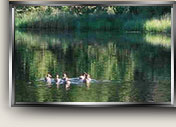Oregon Department of Forestry
Standards for Private Property Certification Under
SB 360
(Forestland-Urban Interface Fire Protection Act of
1997)
629-044-1055
Standards
(1) Owners of lands classified by a committee as Low are not
required to comply with the standards, however, they are encouraged
to review their individual situation and to apply those standards
which may be appropriate.
(2) Owners of lands classified by a committee as Moderate, High,
Extreme, or High Density Extreme shall comply with the standards
applicable to their lands. In meeting this requirement, owners shall
apply one or more of the following:
(a) The default standards set forth in OAR 629-044-1060, which
are intended for the majority of owners;
(b) The optional standards set forth in OAR 629-044-1065, which
are intended for owners who are unable to meet the default
standards; or
(c) The alternate standards developed pursuant to OAR
629-044-1070, which are intended for owners who wish to address site
specific conditions or unique situations.
(3) Owners are encouraged to exceed the standards and to apply
additional wildfire safety measures.
Stat. Auth.: ORS 477.059
Stats. Implemented: ORS 477.059
Hist.: DOF 9-2002, f. 9-19-02, cert. ef.11-15-02
629-044-1060
Default Standards
(1) Where structures exist on lands classified by a committee as
Moderate, High, Extreme, or High Density Extreme owners shall:
(a) Provide and maintain primary fuel breaks which comply with
the requirements of OAR 629-044-1085 (which see below) and which are:
(A) Immediately adjacent to structures, for a distance of at
least 30 feet, or to the property line, whichever is the shortest
distance. The distance shall be measured along the slope and from
the furthest extension of the structure, including attached
carports, decks, or eaves.
(B) Immediately adjacent to driveways, for a distance of at least
ten feet from the centerline of a driveway, or to the property line,
whichever is the shortest distance. The distance shall be measured
along the slope. Including the driving surface, a fuel break shall
result in an open area which is not less than 13 1/2 feet in height
and 12 feet in width or to the property line, whichever is the
shortest distance.
(b) Provide and maintain secondary fuel breaks which comply with
the requirements of OAR 629-044-1085 (see below) and which are immediately
adjacent to primary fuel breaks, for the distance necessary to
comply with the total fuel break distance specified in Table 2
of this rule, or to the property line, whichever is the shortest
distance. The distance shall be measured along the slope and from
the furthest extension of the structure, including attached
carports, decks, or eaves.
(c) Remove any portion of a tree which extends to within 10 feet
of the outlet of a structure chimney or a stove pipe;
(d) Maintain the portion of any tree which overhangs a structure
substantially free of dead plant material;
(e) Maintain the area under decks substantially free of firewood,
stored flammable building material, leaves, needles, and other
flammable material; and
(f) During times of the year when wildfire may be a threat,
locate firewood, flammable building material, and other similar
flammable material:
(A) At least 20 feet away from a structure; or
(B) In a fully enclosed space.
(2) On all lands classified by a committee as High Density
Extreme, owners shall comply with subsection (1) of this rule and
with the standards set forth in OAR 629-044-1075.
For more information see the Government Impact Page in the
Forestlands section of the Stewardship Plan and see the ODF web site
at http://www.oregon.gov/ODF/FIRE/SB360/sb360.shtml
629-044-1085
Fuel Break Requirements
(1) The purpose of a fuel break is to:
(a) Slow the rate of spread and the intensity of an advancing
wildfire; and
(b) Create an area in which fire suppression operations may more
safely occur.
(2) A fuel break shall be a natural or a human-made area where
material capable of allowing a wildfire to spread:
(a) Does not exist; or
(b) Has been cleared, modified, or treated in such a way that the
rate of spread and the intensity of an advancing wildfire will be
significantly reduced.
(3) A primary fuel break shall be comprised of one or more of the
following:
(a) An area of substantially non-flammable ground cover. Examples
include asphalt, bare soil, clover, concrete, green grass, ivy,
mulches, rock, succulent ground cover, or wildflowers.
(b) An area of dry grass which is maintained to an average height
of less than four inches.
(c) An area of cut grass, leaves, needles, twigs, and other
similar flammable materials, provided such materials do not create a
continuous fuel bed and are in compliance with the intent of
subsections (1) and (2) of this rule.
(d) An area of single specimens or isolated groupings of
ornamental shrubbery, native trees, or other plants, provided they
are:
(A) Maintained in a green condition;
(B) Maintained substantially free of dead plant material;
(C) Maintained free of ladder fuel;
(D) Arranged and maintained in such a way that minimizes the
possibility a wildfire can spread to adjacent vegetation; and
(E) In compliance with the intent of subsections (1) and (2) of
this rule.
(4) A secondary fuel break shall be comprised of single specimens
or isolated groupings of ornamental shrubbery, native trees, or
other plants, provided they are:
(a) Maintained in a green condition;
(b) Maintained substantially free of dead plant material;
(c) Maintained free of ladder fuel;
(d) Arranged and maintained in such a way that minimizes the
possibility a wildfire can spread to adjacent vegetation; and
(e) In compliance with the intent of subsections (1) and (2) of
this rule.
Return to
Stewardship Plan Table of Contents






